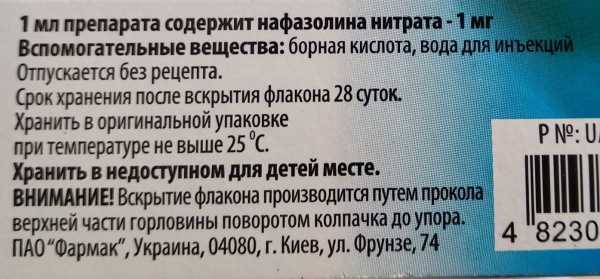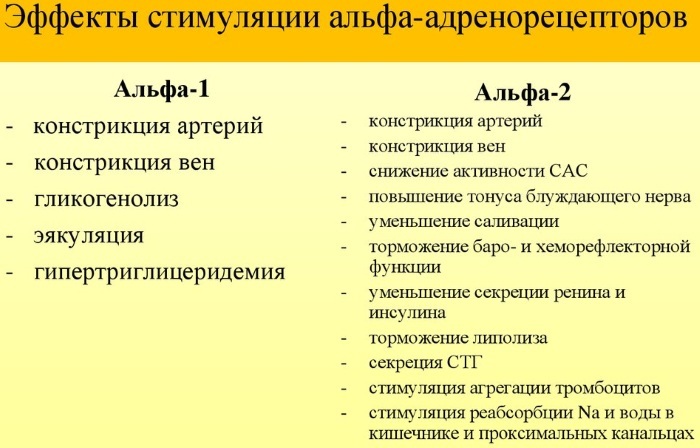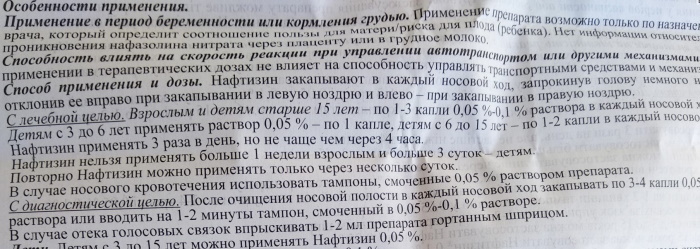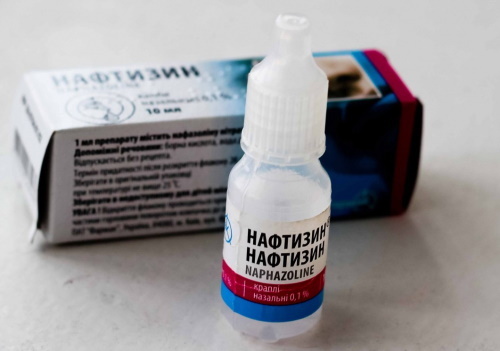Naphthyzine is a drug in the form of drops, often used as a treatment for various eye diseases and related symptoms - inflammation, irritation, redness.
Record content:
- 1 Indications for use
- 2 Chemical composition
- 3 Release form
- 4 Pharmacodynamics
- 5 Pharmacokinetics
-
6 Application
- 6.1 For children under 18
- 6.2 For adults
- 6.3 For pregnant
- 6.4 For the elderly
- 7 Contraindications
- 8 Overdose
- 9 Side effects
- 10 Special recommendations
- 11 Drug interactions
- 12 Storage conditions and periods
- 13 Conditions of dispensing from pharmacies
-
14 Analogs
- 14.1 Octylia
- 14.2 Polynadim
- 14.3 Vizin
- 14.4 Montevizin
- 15 Video about the drug Naphtizin
Indications for use
Naphthyzine is prescribed in the treatment of various disorders in the area of the mucous membranes of the eye, conjunctiva.
Indications for use:
- conjunctivitis, including a chronic course of the disease;
- tearing caused by various negative factors;
- injuries in the area of the mucous membrane of the eye;
- overwork, eye fatigue.
 The drug is used as part of a complex treatment in conjunction with other drugs.
The drug is used as part of a complex treatment in conjunction with other drugs.
Chemical composition
The main active component of the drug is naphazoline, a substance with a pronounced vasoconstrictor and anti-inflammatory effect.
Boric acid and injection water are used as additional ingredients. These components enhance the severity of the therapeutic effect.
Release form
Naphthyzin is produced in the form of a drop solution for topical use in ophthalmology (otolaryngology). Also, the drug can be made in the form of a spray. The medication is in the form of a light-colored liquid. Impurities of yellowish shades are allowed.
The cost of the medicine may vary depending on the region of dispensing and the concentration of the solution:
| Province / region of vacation | Dosage / concentration | Price |
| Moscow, Moscow region | Drops 0.1%, 15 ml | 6-90 rubles. |
| St. Petersburg | Drops 0.05%, 10 ml | 4-86 rubles. |
| Leningrad region | Spray 0.1%, 15 ml | RUB 20-75 |
| Novgorod region | Drops 0.1%, 20 ml | 10-90 rubles. |
You can find out the exact cost of the drug at any pharmacy.
Pharmacodynamics
This agent belongs to the group of alpha-adrenergic agonists with vasoconstrictor and decongestant action.
Pharmacokinetics
The medicine has a local pronounced vasoconstrictor and anti-inflammatory effect. When applied topically, the effect is observed a few minutes after installation. The duration of exposure lasts for several hours.
When the agent is applied to the mucous membrane of the eye, the severity of irritation and hyperemia decreases, and inflammation is eliminated. When applied topically, the drug causes dilation of the pupils, which can be used in some ophthalmic studies.
The systematic use of a drip solution leads to the elimination of inflammatory reactions, irritation and redness (hyperemia), the sensation of the presence of a foreign body in the eye disappears.
Application
Naphthyzine (eye drops are prescribed strictly according to the recommendations of the attending physician) requires extremely careful and careful use, since it is an otolaryngological agent. Dosing rules and duration depend on the severity of the pathological process and are determined by the attending specialist.
Application rules:
- Before starting the installation, you should thoroughly wash your hands with soap and water.
- Take a comfortable position and unscrew the protective cap.
- During instillation, it is necessary to pull back the lower eyelid and install.
- During the procedure, it is necessary to avoid touching the bottle (tip) to the eye shell or hands.
- After instillation, it is recommended to make several blinking movements to better distribute the solution.
Upon completion of the installation, you must put on a protective cap on the bottle and wash your hands thoroughly.
For children under 18
In childhood, the medication can be used only with the permission of a doctor and under his strict supervision. Dosage regimen: 1 drop of the product in each eye (conjunctival area). Apply the solution in this way no more than 3 times a day. The duration of therapy should not exceed 4-5 days.
For adults
The dosage for adults is 1-2 drops of the product in each eye. Installations are carried out 1 to 3 times a day.
The maximum duration of treatment is no more than 5-6 days.
For pregnant
It is not recommended to use the medication during the period of gestation and feeding of the child, since there is no information about the safety of using the drug in this period of time. However, the medicine can be prescribed during the period of bearing a child only taking into account the potential risks and expected benefits.
The dosage is determined individually, based on the potential risks. The maximum duration of treatment while carrying a child should not exceed 4-5 days.
For the elderly
The drug can be used by elderly patients. In this case, therapy should be carried out only under the supervision of a specialist. Dosages and duration of the course are calculated in each case separately. If necessary, the dosage can be adjusted downward.
Contraindications
Naphthyzine (drops in the eyes are used only if all components are well tolerated) has some restrictions on the appointment associated with the special condition of the patient.
Contraindications:
- intolerance to the components;
- thyrotoxicosis;
- keratitis, keratopathy;
- erosive damage to the eye;
- high blood pressure;
- the period of bearing and feeding the child;
- severe eye diseases;
- angle-closure glaucoma;
- atherosclerotic lesion;
- tachycardia;
- dry eye syndrome;
- dystrophic changes in the corneal layer of the eye;
- arrhythmia;
- diabetes;
- children less than 1 year old.
With extreme caution, the medicine is prescribed in the presence of pheochromocytoma, prostatic hyperplasia, as well as in ischemic heart disease. Before using the medication, you need to make sure that there is no allergy to it.
Overdose
If the indicated dosages are exceeded, negative symptoms may develop. The incidence of adverse reactions in adult patients is much lower than in children.
Overdose:
- lowering body temperature;
- an increase in blood pressure;
- decreased heart rate (bradycardia).
 If these signs occur, it is necessary to stop further use of the drops and consult a specialist for the appointment of symptomatic treatment.
If these signs occur, it is necessary to stop further use of the drops and consult a specialist for the appointment of symptomatic treatment.
Side effects
Eye drops in some cases can lead to the development of negative effects associated with the influence of the active substance or prolonged use of Naphthyzin.
Adverse reactions:
- the development of hyperemia;
- irritation in the area of the mucous membrane of the eye;
- nausea;
- headaches;
- increased heart rate;
- an increase in blood pressure;
- allergic reactions.
 With the development of side effects, including symptoms not noted in the instructions, you should stop further use of the drip solution and consult a specialist.
With the development of side effects, including symptoms not noted in the instructions, you should stop further use of the drip solution and consult a specialist.
Special recommendations
With prolonged use of a drip solution, its therapeutic effect decreases. In this case, in most cases, addiction occurs. In this connection, it is not recommended to use the drug for more than 5-6 days in a row.
It is forbidden to use the medication when wearing contact lenses, since the active substance of the solution is capable of affecting (softening) ophthalmic devices. It is recommended to put on contact lenses no earlier than after 20-30 minutes. after installation.
The drug with a concentration of 0.05% in pediatric practice can be prescribed starting from 1 year. The concentration of the 0.1% solution is contraindicated in children under 6 years of age.
The medicine should be used with extreme caution. It is intended for individual use only. During installations, it is necessary to ensure that the dispenser of the bottle does not come into contact with the membrane of the eye, since otherwise there are risks of re-infection.
If blurred vision or other visual disturbances occur during the period of application of the product, it is recommended to refrain or exercise a high degree of caution when driving or performing work that requires high psychomotor functions.
Drug interactions
The drip solution can interact with some drug groups. Thus, it is forbidden to simultaneously use the agent in conjunction with MAO inhibitors. It is also recommended to refrain from using the medication for 2 weeks after stopping the intake of MAO inhibitors.

It is not recommended to use in conjunction with other topical ophthalmic preparations. Local anesthetics can enhance the effect of the drip.
Before using the main medication, you must inform the doctor in advance about other medications being taken. This will reduce or completely eliminate the risks of possible drug interactions.
Storage conditions and periods
- The product should be stored at a temperature of 10 to 25 0C.
- Shelf life - 3 years from the date of production, marked on the package.
- After opening the bottle, the product can be used for 1 month.
- Do not use after the expiration date.
Conditions of dispensing from pharmacies
The drug is dispensed without a prescription.
Analogs
Naphthyzine (eye drops should be replaced with other similar drugs only after prior consultation with a doctor) if it is poorly tolerated, it should be replaced with other similar medications.
Octylia
This medicine is produced in Italy in the form of ophthalmic drops. The active ingredient of the agent is tetrizoline hydrochloride.
The analog belongs to the group of alpha-adrenergic drugs with a pronounced vasoconstrictor effect. Both drugs have similar indications, however, the substitute, unlike the original solution, belongs to the class of ophthalmic agents.
Indications for the use of the generic are various eye diseases, which are accompanied by irritation or hyperemia of the lining of the eyes.
Contraindications:
- dry eye syndrome;
- dystrophic changes in the stratum corneum of the eye;
- glaucoma;
- children under 3 years old;
- intolerance to the components of the drip solution.
The dosage regimen and duration of use for both drugs is identical: 1-2 drops in each eye from 2 to 3 times a day for 4 days. In the future, a specialist consultation is required. This tool is more effective, but has a high cost in comparison with the original drug.
Dispensing method - without a prescription. The cost of an analogue in regional and regional pharmacies in Russia ranges from 210 to 545 rubles.
Polynadim
This drug is produced in Russia in the form of a solution intended for topical use in ophthalmology. It has high antiallergic and vasoconstrictor properties and is made on the basis of 2 active ingredients - diphenhydramine and naphazoline.
The generic and the original have similar indications. Thus, the substitute is used for conjunctival lesions of the eyes, including allergic forms of the disease. Also, the tool can be used for infectious pathologies accompanied by acute allergic reactions.
Dosage regimen: 1 drop of solution in each eye with an interval of 3 hours. Then they switch to a different dosage regimen: 1-2 drops of the drug from 2 to 3 times a day. The duration of therapy should not exceed 5 days. The drugs have identical contraindications and restrictions on admission, including pregnancy and children under 2 years of age.
Generic is prescribed much more often, since it is a narrowly targeted drug intended for the treatment of ophthalmic disorders. The way of implementation is without a prescription. The cost of a substitute in Moscow and regional pharmacies ranges from 30 to 150 rubles.
Vizin
Naphthyzine (eye drops should be used only under the supervision of a physician) can be replaced with this medication if the components of the main drug are poorly tolerated.
This substitute is produced in Russia in the form of drops for local use in ophthalmology. The active substance of the drug is tetrizoline hydrochloride. Belongs to the generic group of alpha-adrenergic agonists.
The indications for the appointment are swelling and redness in the conjunctiva, caused by the influence of various negative factors. The medicine is prescribed for adults and children from 2 years of age. This analogue has a similar scheme of use: 1-2 drops of solution in each eye no more than 2-3 times a day. It is forbidden to use the product for more than 4 days in a row.

Vizine is a more expensive analogue of Naphthyzine, however, it is prescribed much more often, since it has more pronounced therapeutic effect and less likelihood of developing negative local reactions.
Contraindications:
- angle-closure glaucoma;
- children under 2 years of age;
- the period of bearing and feeding the child;
- intolerance to the components of the drug;
- dystrophic disorders in the area of the stratum corneum.
Terms of sale - without a prescription. The cost of a substitute in Russian pharmacies varies from 65 to 780 rubles.
Montevizin
This medicine is produced in Serbia as an eye instillation solution. The active ingredient of the drug is tetrizoline hydrochloride. Drops belong to the group of alpha-adrenergic agents that exhibit high anti-inflammatory and vasoconstrictor properties.
The substitute has similar recommendations for use. However, unlike the main drug, it has a more pronounced and rapid therapeutic effect. At the same time, the generic drug is much less likely to cause adverse reactions, but has a stricter age range (prescribed from the age of 6).
Indications:
- swelling and irritation in the conjunctival region, including reactions caused by the negative effects of external factors;
- redness of the conjunctiva caused by various allergic reactions.
Scheme of use: 1-2 drops of the product from 2 to 3 times a day. In the absence of a therapeutic effect within the next 2 days, it is necessary to consult a specialist for advice.
Contraindications:
- intolerance to the components;
- children under 6 years of age;
- glaucoma;
- the period of bearing and feeding the child;
- dystrophic disorders in the cornea.
The method of sale is without a prescription. The cost of a drip solution is from 105 to 640 rubles.
Before using drops, it is recommended to read the instructions for their use and consult a specialist. Additionally, it is necessary to study the reviews of patients who used Naphthyzin as a treatment for various eye diseases.
Video about the drug Naphtizin
Instructions for the use of Naphtizin:



